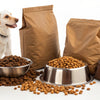Can Dogs Eat Frozen Kibble? Understanding the Benefits and Safety of Feeding Frozen Dog Food
- Houndsy
Table of Contents
- Introduction
- The Benefits of Feeding Frozen Kibble
- Types of Frozen Dog Food: Understanding Your Options
- Safety Precautions When Feeding Frozen Kibble
- Transitioning to Frozen Kibble
- Conclusion
Introduction
As devoted pet parents, we constantly seek ways to enhance our dogs' diets and overall well-being. Did you know that a growing number of dog owners are turning to frozen food options? According to recent studies, approximately 30% of pet owners have experimented with frozen diets for their pets. This trend prompts an essential question: can dogs eat frozen kibble?
In this blog post, we will explore the nuances of feeding frozen kibble to our canine companions. We will cover its benefits, safety considerations, and practical tips for introducing frozen food into your dog's diet. By the end of this article, you will have a comprehensive understanding of feeding frozen kibble, empowering you to make informed decisions about your dog's nutrition.
Let’s dive into the specifics and reflect on our own feeding routines. Have you ever considered the impact of kibble temperature on your dog’s health? As we journey through this topic, we invite you to think about how your current practices can be adapted for the better.
The Benefits of Feeding Frozen Kibble
Feeding frozen kibble offers several advantages that can enhance your dog’s daily eating experience. Here are some key benefits:
1. Enhanced Nutritional Value
One of the most significant benefits of frozen kibble is the preservation of nutrients. Freezing helps retain essential vitamins and minerals that may be lost during traditional cooking methods. By choosing high-quality frozen kibble, we can ensure our pets receive well-balanced nutrition that supports their overall health.
2. Improved Palatability
Many dogs find frozen kibble more appealing than its dry counterpart. The cold temperature can enhance the flavor and aroma, making mealtime more enticing. For picky eaters or dogs recovering from illness, frozen kibble can serve as a delicious and nutritious option that encourages them to enjoy their meals.
3. Digestion and Hydration
Feeding frozen kibble can also aid in digestion. The moisture content in frozen food helps prevent dehydration, especially in dogs that may not drink enough water throughout the day. This is particularly beneficial in warmer months when hydration is crucial.
4. Convenience and Storage
Frozen kibble is easy to store and allows for bulk purchases, reducing the need for frequent trips to the pet store. By investing in a reliable storage solution, like the Houndsy Kibble Dispenser, we can maintain optimal freshness and portion control, ensuring our dogs receive the right amount of food every time.
5. Variety and Customization
Frozen kibble opens up a world of options. From different proteins to unique flavor combinations, we can cater to our dogs' specific dietary needs and preferences. This variety not only keeps mealtime exciting but also allows us to customize our dogs’ diets according to their health requirements.
Types of Frozen Dog Food: Understanding Your Options
When it comes to frozen kibble, we have several options to choose from:
1. Commercial Frozen Kibble
This type of kibble is produced by various reputable brands and is designed to be nutritionally complete. Most commercial frozen kibble is formulated with high-quality ingredients and can provide a balanced diet for our dogs. However, it’s essential to read labels carefully and choose brands that prioritize natural ingredients without fillers or artificial additives.
2. Homemade Frozen Kibble
For those of us who enjoy cooking for our pets, making homemade frozen kibble can be a rewarding option. By blending fresh meats, vegetables, and grains, we can create customized meals tailored to our dogs’ individual health requirements. Just ensure that the recipes are balanced and include necessary nutrients.
3. Raw Frozen Kibble
Raw frozen kibble is becoming increasingly popular among dog owners who wish to mimic their pets' ancestral diets. This type of kibble typically consists of raw meat, bones, and organs, providing a nutrient-rich meal that is minimally processed. While it can be beneficial, it’s crucial to handle raw food safely to prevent any health risks.
Safety Precautions When Feeding Frozen Kibble
While feeding frozen kibble can be beneficial, we must take certain precautions to ensure our dogs' safety and health:
1. Thawing Properly
Thawing frozen kibble is essential for easier digestion and consumption. It is generally recommended to thaw kibble in the refrigerator or under cold water rather than at room temperature. This helps prevent the growth of harmful bacteria.
2. Avoiding Harmful Ingredients
As responsible pet owners, we must avoid feeding our dogs frozen kibble that contains harmful ingredients. Always check labels for additives, preservatives, and allergens that may pose a risk to our pets. Ingredients like garlic, onions, and certain artificial sweeteners can be toxic to dogs.
3. Gradual Introduction
Introducing frozen kibble into our dogs’ diets should be done gradually. Start by mixing a small amount of frozen kibble with their regular food, slowly increasing the quantity over time. This helps our dogs adjust to the new texture and temperature without causing digestive upset.
Transitioning to Frozen Kibble
Transitioning our dogs to frozen kibble doesn’t have to be a daunting task. Here’s how we can do it smoothly:
1. Monitor Portion Sizes
Using a reliable feeding tool, such as the Houndsy Kibble Dispenser, helps us maintain the right portion sizes for our dogs. This ensures they receive adequate nutrition without overeating.
2. Observe Reactions
As we introduce frozen kibble, it's essential to monitor our dogs for any signs of adverse reactions. Look for changes in behavior, appetite, or digestion. If any issues arise, consult a veterinarian for guidance.
3. Adjusting to Preferences
Every dog is unique, and preferences can vary. If your dog seems hesitant about frozen kibble, experiment with different flavors or thawing methods to see what works best for them.
Frequently Asked Questions
Is it safe for dogs to eat frozen kibble?
Yes, as long as it is thawed properly and contains safe ingredients, frozen kibble can be a nutritious option for dogs.
Can puppies safely consume frozen puppy food?
Puppies can eat frozen food, but it’s crucial to ensure that the food is specifically formulated for their growth needs. Consult your vet before introducing any new diet.
How often can dogs eat frozen kibble?
Frozen kibble can be fed daily, but portion sizes should be adjusted according to your dog's size, age, and activity level.
Do you need to defrost frozen dog food before serving it to dogs?
Yes, it is generally recommended to thaw frozen dog food before serving to aid in digestion and prevent choking hazards.
Are dogs able to eat frozen raw meat without any health risks?
Dogs can eat frozen raw meat, but proper handling and thawing are essential to minimize health risks. Always consult your vet when introducing raw foods.
Can dogs have frozen bones, and are they safe?
Feeding dogs frozen bones is generally not recommended, as they can shatter and pose a choking hazard. Raw bones should be given instead, and always under supervision.
Conclusion
Feeding frozen kibble can be a fantastic way to enhance our dogs' diets and overall health. As we’ve explored, the benefits include improved nutrition, enhanced palatability, and convenience. However, it’s crucial to take proper precautions and gradually introduce frozen options into our dogs' routines.
As we reflect on our feeding practices, let’s consider how incorporating the Houndsy Kibble Dispenser can streamline the process, ensuring our pets receive the right portions while maintaining optimal freshness. Together, we can elevate our dogs’ feeding experience, making it not just a necessity but a joyful part of their day.
If you’re ready to explore the world of frozen kibble, check out the Houndsy Kibble Dispenser today and simplify your dog feeding routine while keeping it beautifully designed and functional!













